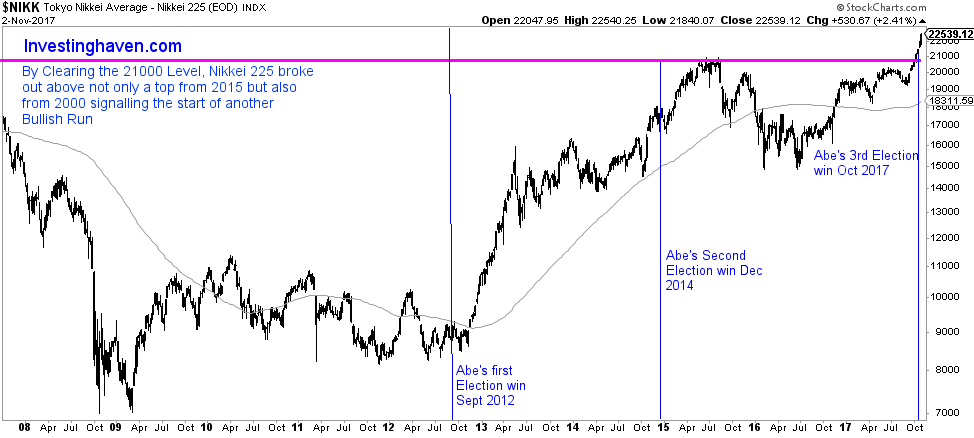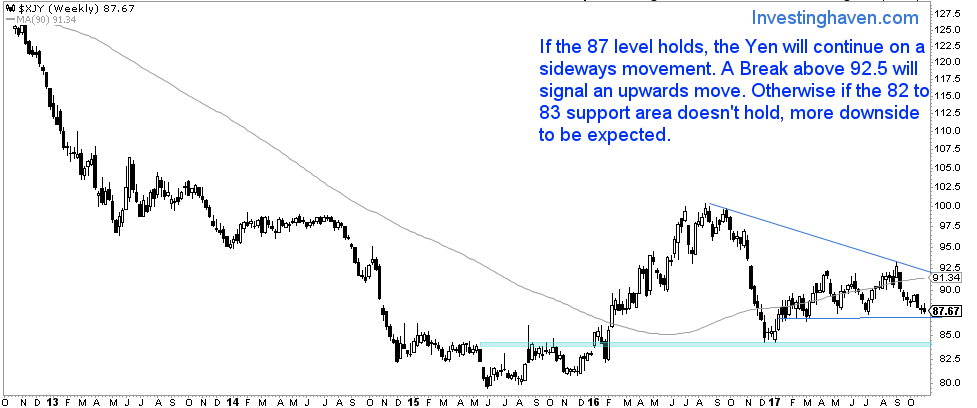This NIKKEI 225 Forecast for 2018 covers the question top of mind of many investors today: will Tokyo’s NIKKEI 225 continue on its impressive upwards run which accelerated early 2017? Will the Reviving Stimulus program or what the world is commonly referring to as Abenomics be enough to keep the Nikkei 225 rally going?
Eleven months ago, at InvestingHaven, we said that The Nikkei 225 chart looks Bullish, Right after the announcement of Abe’s win, we reiterated that the Nikkei 225 chart still looks constructive. For 2018, we think the Bull market will continue for Nikkei 2018.
As usual, we will look at the charts to find indications of the next moves. Our goal is to provide our readers with our Nikkei 225 forecast for 2018, price levels to watch for and Threats that could invalidate our outlook so they can react to changes quick enough. As usual due diligence and managing risk is of the utmost importance to preserve capital.
A NIKKEI 225 Forecast for 2018: The Chart Setup
The chart set up signals the start of a new bull market for Japanese equities provided the 21,000 level holds. In terms of price targets the 25,000 level is definitely on deck. The 30,000 level could get reached as well though it will depend on multiple factors.
As shown by the chart below, the Nikkei got a boost first from the prospect of Abenomics and later on from the economical stimulus that was crafted by the prime minister and supported by Haruhiko Kuroda, Bank of Japan’s governor.
We see below how right after Abe’s first election in September 2012, the market rallied. Nikkei 225 consolidated gains and broke the important 21000 level after Abe’s recent election win. The 21000 level was a top in 2000 and 2015.
Given the importance of the resistance that was just broken we think the upcoming move will be important, and a run upwards might be in store provided the 21,000 holds as a support now.
Factors impacting our NIKKEI 225 Forecast for 2018
Threats that could invalidate our NIKKEI 225 Forecast for 2018 are related to the performance of the Yen and how Abe’s planned tax hike unfolds.
Abe’s plan is to stay in office till 2021 so he needs to win the The Liberal Democratic Party Chief election scheduled for fall 2018. For his cabinet approval to be high he needs the economy to perform strongly. We have seen how he already delayed the Tax hike right before his election win. We expect future decisions to be in the same direction.
Another expected move to keep an eye on is Japan stance on re-instating nuclear power reactors. Japan electricity costs are extremely high and nuclear power is economically attractive and can help cut an important cost.
And that brings us to the YEN. In terms of the national currency, Tokyo has been maintaining a weaker Yen to boost exports and remain competitive. The question now is how long will they be able to maintain it at these levels? And as much as a lower currency can help exports, companies need to remain competitive and mainly innovate to survive in today’s competitive markets.
The Yen is currently in a sideways movement and has yet to choose a direction. We believe the next move is likely to the downside given the direction the government is taking. Should the Yen breakout to the upside, that might be a threat to the materialization of our forecast.
In addition to the Yen, investors should also keep a close watch on the developments around Abe’s tax hike. The hike is due for October 2019 and could easily trigger a correction. It could also cause a selloff depending on how it is positioned and interpreted by the market.
How to play the Nikkei 225 upwards trend
There are multiple ways to get exposure to Japanese markets. Investors could look into specific equities or ETFs. We chose the EWJ ETF. Just like the Nikkei 225, EWJ is on an uptrend and has actually been in a 3 year consolidation period. As long as the 52 level holds, the upwards move is very likely to continue.






